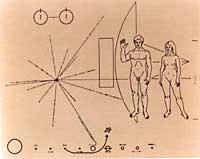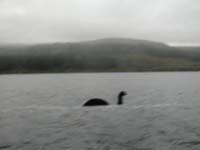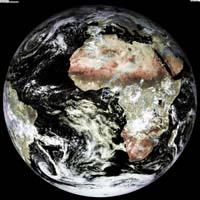The Science and Technology Week starts
2006/11/08 Galarraga Aiestaran, Ana - Elhuyar Zientzia

For example, at the round table held at the Experience Classrooms of the UPV/EHU in Bilbao, the room was small to welcome the entire audience. You can not deny the appeal of the subject: Mysteries in the light of science. Strange beings like aliens, yetia, etc., and times of war, among others.
What does science think about them? All the speakers agreed that, from a scientific point of view, they have no credibility. To begin with, astrophysicist Augustine Sanchez-Lavega spoke about aliens. He acknowledged that it is logical to think that there can be life outside the planet Earth, because the universe is very large and there are many galaxies. But he made it clear that all attempts to find an alien life have been barren for the time being.
Many witnesses, but without evidence

Plates sent to jail on Pioneer 1 and Pioneer 2 vessels.
There and here, and in times more than in others, people appear who say they have seen some alien or flying object. But most of the time they have no evidence and scientists have shown that they were false in those who have had them. According to Sanchez-Lavega, such cases should not be studied by astronomers, but by sociologists, psychiatrists, or sometimes judges, “for deceiving people.”
However, scientists do not totally discard the idea that somewhere there may be extraterrestrial life. Thus, he explained what it takes to create life and why there is life on Earth and not on Venus and Mars. Finally, Sanchez-Lavega pointed out that in the spacecraft Pioneer 1 and Pioneer 2, he does not want to lose hope that someone will ever discover the plates sent into space.
Nessie, yetia and others

After the astrophysicist took the word the biologist Eduardo Angulo, who spoke of cryptozoology. Cryptozoology analyses beings that exist, but have not been tested and are not recognized by science, such as Nessie , yetia ...
Angulo's talk was really humorous. He took each of those beings, showed the evidence that the witnesses had brought about them, and then explained that these tests were a fraud.
For example, one of the best-known photographs of the mysterious being of Loch Ness was taken by a surgeon in 1934. Well, he was not actually a surgeon, but a gynecologist. But, apparently, surgeons were more famous at the time and the photographer was spread as a surgeon. One or the other does not matter, since he was a liar: the photographer recognized before dying, in the 1990s, that the monster that, according to calculations based on the image, measured about 30 m, was a doll of 30 cm.
As in the case of Nessie, in all the others, scientists showed that the tests were false or created by natural phenomena. That is, although cryptozoology has a serious name, it is not very serious.
Magical weather predictions
The next speaker, physicist Jon Saenz, was more serious than Angulo. He is a specialist in climatology and does not think it appropriate for wartime and meteorology to appear in the media at the same level.

In the words of Jon Saenz, “interest in times of war is somewhat understandable.” They have an anthropological and cultural value, but the weather predictions made during those days have no scientific basis.
Jon Saenz explained how meteorological prediction is made and explained why forecasts are not worth at a given point at any given time, even less when the deadline is so long (90 days, nothing more). Although some of the explanations were quite technical, people heard the explanations and heard more than one laughter in the room.
In addition to the Jon Saenz round, many of the listeners could not take their smile even when journalist Mauricio Jose Schwarz acted. The journalist spoke of beliefs and critical thinking. To finish, a round table was held with biophysicist Félix Goñi and the rector of the UPV, Juan Ignacio Pérez Iglesias.
And this has not been more than an act, there are many more throughout the week. Don't miss it!




